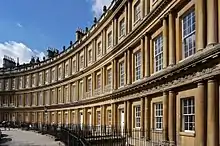Tourism in England
Tourism plays a significant part in the economic life of England. In 2018, the United Kingdom as a whole was the world's 10th most visited country for tourists,[2] and 17 of the United Kingdom's 25 UNESCO World Heritage Sites fall within England.[3]


England is the largest of the four "home nations" that make up the United Kingdom. It is also the most populous of the four with almost 52 million inhabitants (roughly 84% of the total population of the UK). On the island of Great Britain, Scotland sits to the north of England and Wales is to the west. Northern Ireland (also part of the UK) and the Republic of Ireland lie across the Irish Sea to west of England (and Wales). France and the Channel Islands are across the English Channel to the south, and to the east is the North Sea.
VisitEngland is the official tourist board for England. VisitEngland's stated mission is to build England's tourism product, raise Britain’s profile worldwide, increase the volume and value of tourism exports and develop England and Britain’s visitor economy.[4] In 2020, the Lonely Planet travel guide rated England as the second best country to visit that year, after Bhutan.[5]
Cities
The ten English cities visited most by overseas tourists in 2019 were:[6]
- London — largest metropolitan area in Western Europe, and a global capital of finance, fashion, art and culture. In 2019, more than half of overseas tourists visiting the UK included a trip to London.[6]
- Manchester — The third most visited city in the UK, a cultural, sporting, entertainment, shopping and media hub.
- Birmingham — the UK's second largest city (by population) in the industrial heartland.
- Liverpool — The home of the Beatles, a cosmopolitan city famous for its vibrant nightlife, rich cultural heritage, waterfront, architecture, and music and sport.
- Brighton and Hove — regency seaside resort and university town with quirky shopping, rich culture and vibrant gay nightlife.
- Bristol — vibrant music and art scene, historic buildings, a waterfront area in the West Country's largest city.
- Oxford and Cambridge — university towns with prestigious colleges, museums, and gardens.
- Bath — UNESCO World Heritage Site city renowned for its Georgian architecture, gardens, parks, and museums.
- Leeds — cultural, financial and commercial heart of west Yorkshire
Tourist sites
Museums and galleries

Unlike other countries, most state-run museums and places of cultural interest in England are free of charge to visit. Museums are an important aspect of English culture, and most cites and towns have a few museums and art galleries. Some of the most visited places are:
World Heritage Sites
17 of the 25 United Kingdom UNESCO World Heritage Sites fall within England. Some of the best known of these include Stonehenge, the Tower of London, the Jurassic Coast, Westminster, the Roman Baths in Bath, Saltaire, Ironbridge Gorge and Studley Royal Park.
The northernmost point of the Roman Empire, Hadrian's Wall, is the largest Roman artefact in the world, running a total of 73 miles in northern England.[8]
Most visited sites
| National Rank | Site | Location | Visitor count (2009)[9] |
|---|---|---|---|
| Tower of London | London | 2,389,548 | |
| St Paul's Cathedral | London | 1,821,321 | |
| Westminster Abbey | London | 1,449,593 | |
| Roman Baths | Bath | 1,196,481 | |
| Canterbury Cathedral | Canterbury | 1,013,118 | |
| Stonehenge | Amesbury | 990,705 | |
| Palace of Westminster | London | 963,362 | |
| York Minster | York | 797,100 | |
| Chatsworth House | Chatsworth | 652,969 | |
| Leeds Castle | Maidstone | 646,801 | |
| Hampton Court Palace | London | 541,646 | |
| Blenheim Palace | Woodstock | 537,120 | |
| Portsmouth Historic Dockyard | Portsmouth | 532,158 | |
| Stourhead | Mere | 356,816 | |
| Beaulieu Palace House and Abbey | Beaulieu | 351,975 |
National Parks

Some notable National Parks in England include:
- Lake District National Park — mountains, lakes and woodlands; the land of Wordsworth.
- New Forest National Park — one of the few remnants of the great oak and hornbeam woodland that once covered southern England.
- North York Moors National Park — heather-clad hills, woodlands, sea cliffs and secluded beaches
- Peak District National Park — rugged moors and hills which form the northern spine of England.
- South Downs National Park — the gentle rolling chalk downs of southern England.
England possesses a wide range of natural environments, and continues to benefit from a significant ecotourism industry. Attractions include:[10]
- Eden Project in Cornwall.
- The Lake District, a national park and mountainous region in Cumbria, including Windermere, the largest lake in England.
- The Peak District, a national park and upland area lying mostly in Derbyshire.
- Dartmoor and Exmoor, national parks and upland areas in Devon/Somerset.
- The New Forest, a rural forest and national park lying mostly in Hampshire.
- The Jurassic Coast, a World Heritage Site in Dorset and Devon.
- The Broads, a national park and lowland area lying mostly in Norfolk.
- The Yorkshire Dales, a national park and upland area in North Yorkshire and Cumbria.
- The National Forest, covering parts of Leicestershire, Derbyshire and Staffordshire.
- The South Downs, a national park stretching from Hampshire to East Sussex and comprising chalk uplands and sea cliffs.
- Center Parcs, a European network of rural holiday parks.
Preservation trusts
A number of umbrella organisations are devoted to the preservation and public access of both natural and cultural heritage, including English Heritage and the National Trust. Membership with them, even on a temporary basis, gives priority free access to their properties thereafter.
English Heritage has a wide-ranging remit and manages more than 400 significant buildings and Monuments in England. They also maintain a register of thousands of listed buildings,[11] those which are considered of most importance to the historic and cultural heritage of the country.
Travelling within England
.jpg.webp)
The United Kingdom's bus services offers numerous, frequent and reliable transport around most of the larger towns and cities. Rural areas are less well served and hiring a car is often the best option to explore the countryside and villages.
The next most common methods of transports are taxis and trains. Great Britain's extensive rail network is used to travel between cities significantly more than aeroplanes, with a 2015 survey finding that only 1% of international visitors flew domestically after arrival.[12]
Politics
The Parliamentary Under Secretary of State for Arts, Heritage and Tourism is the minister with responsibility over tourism in the UK.[13]
See also
References
- "The London Eye a complete visitor guide". The Daily Telegraph. Retrieved 1 May 2014.
- "International Tourism Highlights, 2019 Edition". www.e-unwto.org. doi:10.18111/9789284421152.
- "Every UNESCO World Heritage Site in the UK". TripSavvy.
- "Overview". visitbritain.org. 10 April 2015.
- "Best in Travel 2020". Lonely Planet. 2019. Retrieved 24 April 2020.
- "Travel trends - Office for National Statistics". www.ons.gov.uk. Retrieved 18 July 2020.
- "Annual Survey of Visits to Visitor Attractions: Latest results". VisitBritain. 22 November 2016. Retrieved 10 July 2020.
- "10 Interesting Facts About Hadrian's Wall | Learnodo Newtonic". learnodo-newtonic.com.
- "VISITS MADE IN 2009 TO VISITOR ATTRACTIONS IN MEMBERSHIP WITH ALVA". Association of Leading Visitor Attractions. Archived from the original on 31 October 2010. Retrieved 21 May 2010.
- "Discover the UK's Best Eco-Friendly Destinations | HomeToGo". HomeToGo - the search engine for holiday rentals.
- "English Heritage". www.english-heritage.org.uk. Retrieved 18 July 2020.
- "Inbound transport research". VisitBritain. 20 April 2015. Retrieved 18 July 2020.
- "Parliamentary Under Secretary of State for Arts, Heritage and Tourism - GOV.UK". www.gov.uk. Retrieved 2020-01-29.
External links
 Text was copied from England at WikiTravel, which is released under a Creative Commons Attribution-Share Alike 3.0 (Unported) (CC-BY-SA 3.0) license.
Text was copied from England at WikiTravel, which is released under a Creative Commons Attribution-Share Alike 3.0 (Unported) (CC-BY-SA 3.0) license.- England travel and tourism at Curlie
- English Tourist Board
- England Wiki Travel guide
- Best UK Places
- www.pagemost.com, Interactive Google maps showing local places and attractions, complete with Flickr photographs. Search by UK place name or postcode.